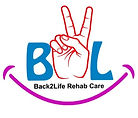
B2LCARE'S Physiotherapist guide to Low Back Pain

If you have low back pain, you are not alone. At any given time, about 25% of people in the United States report having low back pain within the past 3 months. In most cases, low back pain is mild and disappears on its own. For some people, back pain can return or hang on, leading to a decrease in quality of life or even to disability.
If your low back pain is accompanied by the following symptoms, you should visit your local emergency department immediately:
-
Loss of bowel or bladder control
-
Numbness in the groin or inner thigh
Signs and Symptoms
The symptoms of low back pain vary a great deal. Your pain might be dull, burning, or sharp. You might feel it at a single point or over a broad area. It might be accompanied by muscle spasms or stiffness. Sometimes, it might spread into 1 or both legs.
There are 3 different types of low back pain:
-
Acute – pain lasting less than 3 months
-
Recurrent – acute symptoms come back
-
Chronic – pain lasting longer than 3 months
Most people who have an episode of acute pain will have at least 1 recurrence. While the actual cause of low back pain isn't often known, symptoms usually resolve on their own. Psychosocial factors, such as self-confidence and a perceived ability to cope with disability, have been shown to be predictors of who might not recover from low back pain as expected. We used to believe the cause of low back pain was related directly to the tissues of our body, but are now understanding the condition to be more complex.
Although low back pain is rarely serious or life threatening, there are several conditions that may be related to your low back pain, such as:
-
Degenerative disk disease
-
Lumbar spinal stenosis
-
Fractures
-
Osteoarthritis
-
Osteoporosis
-
Tumors of the spine
While we used to believe the above list contributed directly to low back pain, research has shown these conditions are also present in people without any pain (asymptomatic).
How B2lcare's Physiotherapist help?
Your physical therapist can help you improve or restore mobility and reduce low back pain—in many cases, without expensive surgery or the side effects of medications.
If you are having low back pain right now:
-
Stay active, and do as much of your normal routine as possible (bed rest for longer than a day can actually slow down your recovery.)
-
If your pain lasts more than a few days or gets worse, schedule an appointment to see your physical therapist.
Not all low back pain is the same, so your treatment should be tailored to for your specific symptoms and condition. Once the examination is complete, your physical therapist will evaluate the results, identify the factors that have contributed to your specific back problem, and design an individualized treatment plan for your specific back problem. Treatments may include:
-
Use of electrotherapy modalities (eg. IFT ,SWD ,UST , TENS)
-
Manual therapy, including spinal manipulation, to improve the mobility of joints and soft tissues
-
Specific strengthening and flexibility exercises
-
Education about how you can take better care of your back
-
Training for proper lifting, bending, and sitting; for doing chores both at work and in the home; and for proper sleeping positions
-
Assistance in creating a safe and effective physical activity program to improve your overall health
-
Use of ice or heat treatments or electrical stimulation to help relieve pain











